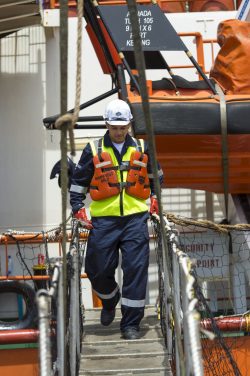The running theme across the many converging challenges facing the shipping industry this year is safety. No surprise then that the International Maritime Organisation (IMO) has announced ‘Navigating the future: safety first!’ as its global shipping vision for 2024.
A vessel is a large, costly piece of equipment, with a whole host of onboard and onshore personnel supporting the safe loading and unloading of cargo. There is a great deal at stake in financial, commercial, environmental and – not least – human terms.

In its Annual Overview of Marine Casualties and Incidents 2023 covering marine casualties and incidents reported by EU member states, the European Maritime Safety Agency (EMSA) revealed a total of 23,814 from 2014 to 2022. After a peak of 106 very serious casualties reported in 2018, the numbers have come down in recent years, reaching 44 in 2022.
That trend proves that attention to safety pays off, and that it should be at the top of the agenda across the industry at all times.
Culture of safety
It’s something we have long taken to heart at GAC. For more than a decade, our safe boarding initiative has been a shining example of how educational efforts can help across supply chains by supporting local suppliers in safety and compliance.
In Singapore, we have introduced a programme to decrease launch boat usage to reduce the potential exposure to risk for personnel and the environment, whilst also saving on costs. GAC Singapore also provides practical man overboard, pilot ladder and life raft safety training for its boarding officers and launch service providers’ crew.
We also offer a firefighting and emergency response using our own fleet of service craft in Sri Lanka and elsewhere.
Our thorough supplier vetting programme plays a crucial role in ensuring the safety of our crew, shipborne personnel, and the wider maritime community. We prioritise suppliers who uphold the highest safety standards, not only to protect our operations but also to strengthen the dependability of our supply chain. This proactive approach doesn't just minimise risks; it establishes us as pioneers in safety-oriented commerce, appealing to stakeholders who value secure and environmentally conscious partnerships.
Careful supplier selection doesn’t just safeguard our assets, it sets a commercial benchmark that reverberates throughout the maritime industry.

Digital foundations
A strong safety culture to support operations must be supported by a data-driven digital framework as an essential tool to easily adopt ways to maximise the safety of seafarers in port, at sea, boarding, off-boarding and at all points in between.
GAC’s QHSSE digital application eases the reporting, investigation and follow-ups of both internal and external parties by drawing on accumulated data to highlight the needs of the global maritime community. Our agents and boarding officers use the app to quickly raise a red flag and even halt operations when they spot safety risks, and to report any incidents that occur during operations.
GAC’s IT processes are ISO 27001-certified, testifying to the security of data gathered and used throughout all our systems, including the HSSE app.
Training
Our core safety message is driven home through online courses available to all our people through the GAC Corporate Academy. These include an introduction to and refresher courses in Health, Safety, Security and the Environment (HSSE), compliance, cybersecurity, Institution of Occupational Safety and Health (IOSH) management, and dedicated sections of the Shipping Agency Operations course and the compulsory employee orientation all new joiners have to complete.
We are even extending that philosophy to suppliers we work with, with the launch of a new course – Compliance and HSSE for Contractors – developed by GAC Hub Services and the Academy. It gives our operational partners access to our online learning tools to ensure safety wherever you go, even in locations where we don’t have a GAC base.
New concerns
Like shipping itself, safety is constantly evolving, with new considerations arising with every passing month.
A safety report published by DNV and Lloyd’s List Intelligence in May 2023 highlighted the need to cultivate improved safety standards against the backdrop of fundamental industrial shifts such as decarbonisation and digitalisation.
The report highlights that the transition to new fuels and engine types –crucial to decarbonisation efforts over the coming decades – will present new safety challenges to ship operators and crew members. Maritime workers are largely unfamiliar with fuels like ammonia and methanol, and they bring their own particular safety hazards. And the engines that they will run on will require additional skills.
It is therefore crucial that safety considerations lie at the heart of the transition to these new technologies, as well as to digital technologies that are rapidly replacing traditional operating systems. This will require new, smart training programmes driven by the realistic considerations of the personnel who will interact most with new technologies.
Safety guidelines and regulations must evolve, but that is no easy task. Regulations traditionally designed for ships and systems of today can become outdated as new machinery, fuels and operating systems become more prevalent. Older regulations can even hinder the application of new technologies, slowing down further development that, in turn, can slow down decarbonisation efforts.
The global rise of the electric vehicles (EV) market presents another challenge. Growing demand for such vehicles as well as their lithium-based components has led to industry worries about the rising number of related fires on board ships, and the difficulty in subduing them, prompting the International Maritime Organisation (IMO) to urge its member states to draw up new safety rules to for safer transportation.
The way forward, together
Stability, strength and competence, as well as a complete suite of services surrounding a vessel’s port call from pre-planning, clearance, cargo handling and documentation, are indispensable as the industry becomes forensic in its approach to safety.
This is especially true when it comes to energy transfer, with bunkering and owners’ matters, all delivered safely, compliantly and effectively.
At GAC, we aim to set the tone through the quality in our local operations, through the people that deliver our service 24/7 across the globe, through our wealth of experience over the past 65 years, and through our culture that encourages vigilance and even halting operations when safety concerns arise.
Maritime safety is, and must remain, at the top of the agenda for us all. But it takes more than the individual efforts of a one company or organisation. Ensuring maritime safety as the industry evolves must be a collaborative effort with the active participation across the global shipping community.